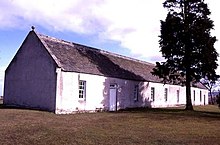History
St Ninian's replaced a church located in St Ninian's burial ground, Chapelford, destroyed by soldiers in 1728. [2] Before the construction of St Ninian's, services were held on an occasional basis, often at night in barns conducted by priests who travelled disguised as farmers. [2]
At the time the church was constructed, the building was an extremely modest private house owned by a "poor woman." [2] [3] Although the existence of a Roman Catholic congregation and the fact that they intended to construct a space in which to conduct communal worship was not a secret, in keeping with the conditions under which Catholic worship was tolerated in Scotland, Father Godsman purchased the house, on land owned by the Gordon family, and announced that he was "making anadditione (sic) as a cotfor his sheep." [3] In its original form, the building was thatched and the windows were not glazed. Glass windows and a slate roof were added by Father George Matheson in 1779, as conditions eased for Roman Catholics in Scotland. Father Matheson added a ball finial on the building's west gable. [1] The building was restored in 1951. [2]
St Ninian's is still a consecrated church, although it was supplanted as the leading church in the parish by St Gregory's, Preshome in 1788. [3] The church is protected as a category A listed building. [4]
This page is based on this
Wikipedia article Text is available under the
CC BY-SA 4.0 license; additional terms may apply.
Images, videos and audio are available under their respective licenses.
